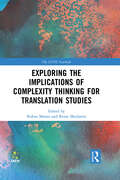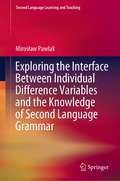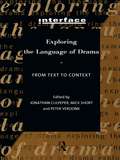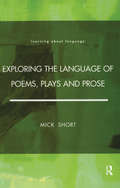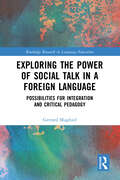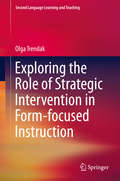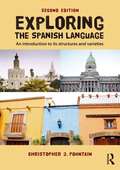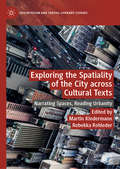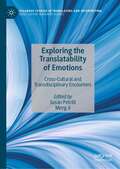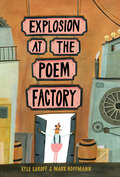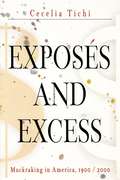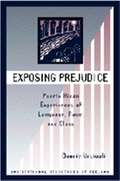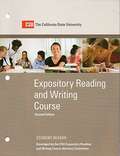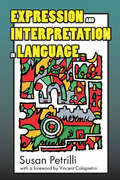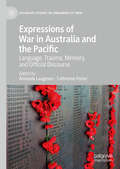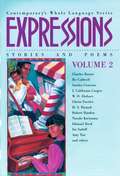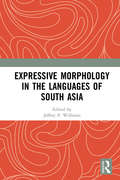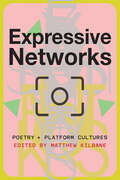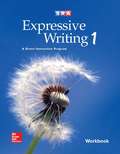- Table View
- List View
Exploring the Horror of Supernatural Fiction: Ray Bradbury’s Elliott Family (Routledge Studies in Twentieth-Century Literature)
by Steve Gronert Ellerhoff Miranda CorcoranDetailing the adventures of a supernatural clan of vampires, witches, and assorted monstrosities, Ray Bradbury’s Elliott family stories are a unique component of his extensive literary output. Written between 1946 and 1994, Bradbury eventually quilted the stories together into a novel, From the Dust Returned (2001), making it a creative project that spanned his adult life. Not only do the stories focus on a single familial unit, engaging with overlapping twentieth-century themes of family, identity and belonging, they were also unique in their time, interrogating post-war American ideologies of domestic unity while reinventing and softening gothic horror for the Baby Boomer generation. Centred around diverse interpretations of the Elliott Family stories, this collection of critical essays recovers the Elliotts for academic purposes by exploring how they form a collective gothic mythos while ranging across distinct themes. Essays included discuss the diverse ways in which the Elliott stories pose questions about difference and Otherness in America; engage with issues of gender, sexuality, and adolescence; and interrogate complex discourses surrounding history, identity, community, and the fantasy of family.
Exploring the Implications of Complexity Thinking for Translation Studies (The IATIS Yearbook)
by Kobus MaraisExploring the Implications of Complexity Thinking for Translation Studies considers the new link between translation studies and complexity thinking. Edited by leading scholars in this emerging field, the collection builds on and expands work done in complexity thinking in translation studies over the past decade. In this volume, the contributors address a variety of implications that this new approach holds for key concepts in Translation Studies such as source vs. target texts, translational units, authorship, translatorship, for research topics including translation data, machine translation, communities of practice, and for research methods such as constraints and the emergence of trajectories. The various chapters provide valuable information as to how research methods informed by complexity thinking can be applied in translation studies. Presenting theoretical and methodological contributions as well as case studies, this volume is of interest to advanced students, academics, and researchers in translation and interpreting studies, literary studies, and related areas.
Exploring the Interface Between Individual Difference Variables and the Knowledge of Second Language Grammar (Second Language Learning and Teaching)
by Mirosław PawlakThe last few decades have seen extensive research focusing of the relative effectiveness of different instructional options that can be employed in teaching grammar structures (e.g., deduction and induction, different types of corrective feedback, input-based vs. output-based practice). However, the contribution of such pedagogical intervention and the resulting knowledge of target language grammar are mediated by a number of factors related to a specific context, the properties of the features being taught and, most importantly, individual learner profiles. Nonetheless, research into the moderating role of individual difference variables has been scant, limited to only several factors, and seldom taking into account complex interactions between variables. The book seeks to fill this evident gap by investigating the mediating effect of selected cognitive and affective factors on explicit and implicit (or highly automatized) knowledge of the English passive voice. In doing so, the study sheds the so-much-needed light on the predictors of second language grammar knowledge but also, to some extent, on the usefulness of instructional techniques used to develop it.
Exploring the Language of Drama: From Text to Context (Interface)
by Jonathan Culpeper Mick Short Peter VerdonkExploring the Language of Drama introduces students to the stylistic analysis of drama. Written in an engaging and accessible style, the contributors use techniques of language analysis, particularly from discourse analysis, cognitive linguistics and pragmatics, to explore the language of plays.The contributors demonstrate the validity of analysing the text of a play, as opposed to focusing on performance. Divided into four broad, yet interconnecting groups, the chapters:* open up some of the basic mechanisms of conversation and show how they are used in dramatic dialogue* look at how discourse analysis and pragmatic theories can be used to help us understand characterization in dialogue* consider some of the cognitive patterns underlying dramatic discourse* focus on the notion of speech as action.there is also a chapter on how to analyse an extract from a play and write up an assignment.
Exploring the Language of Poems, Plays and Prose (Learning About Language Ser.)
by Mick ShortExploring the Language of Poems, Plays and Prose examines how readers interact with literary works, how they understand and are moved by them. Mick Short considers how meanings and effects are generated in the three major literary genres, carying out stylistic analysis of poetry, drama and prose fiction in turn. He analyses a wide range of extracts from English literature, adopting an accessible approach to the analysis of literary texts which can be applied easily to other texts in English and in other languages.
Exploring the Power of Social Talk in a Foreign Language: Possibilities for Integration and Critical Pedagogy (Routledge Research in Language Education)
by Gerrard MugfordThis book examines the fundamental interactional dimension to foreign language communication, including the establishment, development, consolidation and maintenance of interpersonal relations. It argues that interpersonal language use such as small talk, casual conversation and gossipy talk is not only key to meaningful and productive communication but that it is an essential dimension with respect to successful foreign language interaction and that engaging in interpersonal language is communicatively valuable and worthwhile in its own right. Crucially, it explores how teaching and learning can utilize the role of social talk and relational engagement in helping interactants to express, voice and convey their own values, attitudes and beliefs. Finally, it develops a critical relational pedagogy focused on language speakers’ needs, objectives and desires. Redressing the imbalance between transactional and interactional language teaching, and stressing the importance of phatic and relational language use in helping language users achieve their communicative goals, it will appeal to researchers, postgraduates, and scholars in the fields of education and linguistics.
Exploring the Role of Strategic Intervention in Form-focused Instruction
by Olga TrendakThe monograph is devoted to the notion of strategic intervention and its application in the foreign language classroom, in particular with reference to teaching grammar structures. The first four chapters, which are theoretical in nature, address such concepts as form-focused instruction, language learning strategies and strategies-based instruction. The last chapter provides insight into the results of a study investigating the grammar learning strategies employed by advanced learners of English. Additionally, the chapter presents the views of foreign language teachers on the idea of introducing strategy training in the foreign language classroom. The book closes with the discussion concerning the implementation of strategy training and its value in teaching target language grammar.
Exploring the Spanish Language: An Introduction to its Structures and Varieties
by Christopher PountainExploring the Spanish Language is a practical introduction to the structures and varieties of Spanish. This new edition provides updated samples that introduce the varieties of modern Spanish, its main registers and styles, including a greater percentage from Latin America. Written specifically with English-speaking learners of Spanish in mind, readers will find a good deal of practical help in developing skills such as pronunciation and the appropriate use of register. No previous knowledge of linguistics is assumed and a glossary of technical terms, in conjunction with exercises and activities, helps to reinforce key points. Exploring the Spanish Language is ideal for students taking courses on Spanish language and linguistics and provides an ideal foundation for research of the Spanish speaking world.
Exploring the Spatiality of the City across Cultural Texts: Narrating Spaces, Reading Urbanity (Geocriticism and Spatial Literary Studies)
by Martin Kindermann Rebekka RohlederExploring the Spatiality of the City across Cultural Texts: Narrating Spaces, Reading Urbanity explores the narrative formations of urbanity from an interdisciplinary perspective. Within the framework of the “spatial turn,” contributors from disciplines ranging from geography and history to literary and media studies theorize narrative constructions of the city and cities, and analyze relevant examples from a variety of discourses, media, and cities. Subdivided into six sections, the book explores the interactions of city and text—as well as other media—and the conflicting narratives that arise in these interactions. Offering case studies that discuss specific aspects of the narrative construction of Berlin and London, the text also considers narratives of urban discontinuity and their theoretical implications. Ultimately, this volume captures the narratological, artistic, material, social, and performative possibilities inherent in spatial representations of the city.
Exploring the Translatability of Emotions: Cross-Cultural and Transdisciplinary Encounters (Palgrave Studies in Translating and Interpreting)
by Susan Petrilli Meng JiThis book offers an in-depth, cross-cultural and transdisciplinary discussion of the translatability of social emotions. The contributors are leading philosophers, semioticians, anthropologists, communication and translation theorists from Europe, America and Australia. Part I explores the translatability of emotions as a culturally embedded social behaviour that requires a contextualized interpretation of their origins and development in different social and cultural settings. These studies make useful preparations for the studies introduced in Part II that continue investigating the cultural and sociological influence of the development of social emotions with a special focus on the dialogical relation to the body and to others. Part III presses on delving into specific types of emotions which underscore social interactions at both the community and individual levels, such as dignity, (im-)politeness, self-regard and self-esteem. Finally, Part IV offers a further development on the preceding parts as it discusses problems of translation, expressibility and mass-medial communication of emotions. This book will engage translation scholars as well as those with a broader interest in the study and interpretation of emotions from different fields, perspectives and disciplines.
Explosion at the Poem Factory
by Kyle LukoffA funny story, full of wordplay, brings poetry alive as never before! Kilmer Watts makes his living teaching piano lessons, but when automatic pianos arrive in town, he realizes he’s out of a job. He spots a “Help Wanted” sign at the poem factory and decides to investigate — he’s always been curious about how poems are made. The foreman explains that machines and assembly lines are used for poetry these days. So Kilmer learns how to operate the “meter meter” and empty the “cliché bins.” He assembles a poem by picking out a rhyme scheme, sprinkling in some similes and adding alliteration. But one day the machines malfunction, and there is a dramatic explosion at the poem factory. How will poetry ever survive? Kyle Lukoff’s funny story, rich in wordplay, is complemented by Mark Hoffmann’s lively, quirky art. The backmatter includes definitions of poetic feet, types of poems (with illustrated examples) and a glossary of other terms. An author’s note explains the inspiration for the story. Key Text Features definitions glossary author's note Correlates to the Common Core State Standards in English Language Arts: CCSS.ELA-LITERACY.RL.2.4 Describe how words and phrases (e.g., regular beats, alliteration, rhymes, repeated lines) supply rhythm and meaning in a story, poem, or song.
Exposes and Excess
by Cecelia TichiFrom robber barons to titanic CEOs, from the labor unrest of the 1880s to the mass layoffs of the 1990s, two American Gilded Ages--one in the early 1900s, another in the final years of the twentieth century--mirror each other in their laissez-faire excess and rampant social crises. Both eras have ignited the civic passions of investigative writers who have drafted diagnostic blueprints for urgently needed change. The compelling narratives of the muckrakers--Upton Sinclair, Ida Tarbell, Lincoln Steffens, and Ray Stannard Baker among them--became bestsellers and prizewinners a hundred years ago; today, Cecelia Tichi notes, they have found their worthy successors in writers such as Barbara Ehrenreich, Eric Schlosser, and Naomi Klein.In Exposés and Excess Tichi explores the two Gilded Ages through the lens of their muckrakers. Drawing from her considerable and wide-ranging work in American studies, Tichi details how the writers of the first muckraking generation used fact-based narratives in magazines such as McClure's to rouse the U.S. public to civic action in an era of unbridled industrial capitalism and fear of the immigrant "dangerous classes." Offering a damning cultural analysis of the new Gilded Age, Tichi depicts a booming, insecure, fortress America of bulked-up baby strollers, McMansion housing, and an obsession with money-as-lifeline in an era of deregulation, yawning income gaps, and idolatry of the market and its rock-star CEOs.No one has captured this period of corrosive boom more acutely than the group of nonfiction writers who burst on the scene in the late 1990s with their exposés of the fast-food industry, the world of low-wage work, inadequate health care, corporate branding, and the multibillion-dollar prison industry. And nowhere have these authors--Ehrenreich, Schlosser, Klein, Laurie Garrett, and Joseph Hallinan--revealed more about their emergence as writers and the connections between journalism and literary narrative than in the rich and insightful interviews that round out the book.With passion and wit, Exposés and Excess brings a literary genre up to date at a moment when America has gone back to the future.
Exposing Prejudice
by Bonnie UrciuoliPuerto Ricans in the United States, like other migrant minorities, face an array of linguistic judgments. They are told they don’t succeed because they don’t speak English. They are told their English is "impure” or "broken” because it has been "mixed” with Spanish. They are told that they sound inarticulate and that if they speak "correct” English, with no sign of Spanish influence-most particularly with no accent, they will get better jobs. In short, Puerto Ricans in the United States are told that the origins of their economic and social problems are linguistic and can be remedied through personal effort, when in fact their fundamental problems stem from racial and class exclusion. Concepts like "mixed” or "broken” languages, and "good” and "bad” English are cultural constructions and therefore are about more than language. In the Puerto Rican experience of devaluation and prejudice in the United States, the institutionalization of racial exclusion and class location are mapped onto English and Spanish in complex and highly politicized ways. Formal linguistic studies of bilingualism rarely engage this process in a significant way. But the place, function, and meaning of cultural constructs within the politicized communicative economy must be understood in terms of the intersections of race, class, and language that shape the lives of working-class Puerto Ricans. Working from ethnographic studies and interviews done on New York’s Lower East Side and in the Bronx, this book examines that intersection in detail.
Exposing Prejudice
by Bonnie UrciuoliPuerto Ricans in the United States, like other migrant minorities, face an array of linguistic judgments. They are told they don't succeed because they don't speak English. They are told their English is "impure" or "broken" because it has been "mixed" with Spanish. They are told that they sound inarticulate and that if they speak "correct" English, with no sign of Spanish influence-most particularly with no accent, they will get better jobs. In short, Puerto Ricans in the United States are told that the origins of their economic and social problems are linguistic and can be remedied through personal effort, when in fact their fundamental problems stem from racial and class exclusion.Concepts like "mixed" or "broken" languages, and "good" and "bad" English are cultural constructions and therefore are about more than language. In the Puerto Rican experience of devaluation and prejudice in the United States, the institutionalization of racial exclusion and class location are mapped onto English and Spanish in complex and highly politicized ways. Formal linguistic studies of bilingualism rarely engage this process in a significant way. But the place, function, and meaning of cultural constructs within the politicized communicative economy must be understood in terms of the intersections of race, class, and language that shape the lives of working-class Puerto Ricans. Working from ethnographic studies and interviews done on New York's Lower East Side and in the Bronx, this book examines that intersection in detail.
Exposing Prejudice
by Bonnie UrciuoliPuerto Ricans in the United States, like other migrant minorities, face an array of linguistic judgments. They are told they don't succeed because they don't speak English. They are told their English is "impure" or "broken" because it has been "mixed" with Spanish. They are told that they sound inarticulate and that if they speak "correct" English, with no sign of Spanish influence-most particularly with no accent, they will get better jobs. In short, Puerto Ricans in the United States are told that the origins of their economic and social problems are linguistic and can be remedied through personal effort, when in fact their fundamental problems stem from racial and class exclusion.Concepts like "mixed" or "broken" languages, and "good" and "bad" English are cultural constructions and therefore are about more than language. In the Puerto Rican experience of devaluation and prejudice in the United States, the institutionalization of racial exclusion and class location are mapped onto English and Spanish in complex and highly politicized ways. Formal linguistic studies of bilingualism rarely engage this process in a significant way. But the place, function, and meaning of cultural constructs within the politicized communicative economy must be understood in terms of the intersections of race, class, and language that shape the lives of working-class Puerto Ricans. Working from ethnographic studies and interviews done on New York's Lower East Side and in the Bronx, this book examines that intersection in detail.
Expository Reading and Writing Course: Student Reader, Second Edition
by California State University (CSU) Expository Reading Writing Course Advisory CommitteeThe reading selections in this collection form the basis of the CSU Expository Reading and Writing Course (ERWC). The course is designed to foster critical thinking through a rhetorical approach to reading and writing.
Expression and Interpretation in Language
by Susan PetrilliThis book features the full scope of Susan Petrilli's important work on signs, language, communication, and of meaning, interpretation, and understanding. Although readers are likely familiar with otherness, interpretation, identity, embodiment, ecological crisis, and ethical responsibility for the biosphere-Petrilli forges new paths where other theorists have not tread. This work of remarkable depth takes up intensely debated topics, exhibiting in their treatment of them what Petrilli admires-creativity and imagination. Petrilli presents a careful integration of divergent thinkers and diverse perspectives. While she abandons hope of attaining a final synthesis or an unqualifiedly comprehensive outlook, there remains a drive for coherence and detailed integration. The theory of identity being advocated in this book will provide the reader with an aid to appreciating the identity of the theorizing undertaken by Petrilli in her confrontation with an array of topics. Her theory differentiates itself from other offerings and, at the same time, is envisioned as a process of self-differentiation. Petrilli's contribution is at once historical and theoretical. It is historical in its recovery of major figures of language; it is theoretical in its articulation of a comprehensive framework. She expertly combines analytic precision and moral passion, theoretical imagination and political commitment.
Expression and Interpretation of Negation: An OT Typology
by Henriëtte De SwartThis study in cross-linguistic semantics explores the territory where logic, natural language and typology meet. While we can all understand the semantics of negation in its role of altering truth values, this ambitious book aims to take the reader much further. A unified analysis of the linguistic 'behavior' of negation is hampered by the myriad variations in its syntax and semantics in languages around the world. This is true not just for the expression of negatives, but for their interpretation too. De Swart deploys the framework of bi-directional Optimality Theory to develop a typology of the relationship between syntax and semantics in negation markers and negative indefinites. In this model, syntactic and semantic constraints act in concert to define the grammar of a language. Some languages are 'double negative', some 'negative concord', and others belong to subclasses identified by 'strict negative concord' 'nonstrict negative concord' or 'negative spread'. In addition to the above, the author analyses intermediate cases, and examines complex instances of double negation occurring in negative concord languages. Her OT analysis of the Jespersen cycle brings together typological and diachronic variation. This book's unique combination of theoretical precision and wide empirical coverage make it essential reading for any researcher approaching semantic typology from a logical, linguistic or cognitive perspective.
Expressionism (The Critical Idiom Reissued #28)
by R. S. FurnessFirst published in 1973, this book provides a helpful introduction to expressionism in literature. After providing a helpful introduction to the origins and defining characteristics of expressionism, the book traces the movement in Germany from 1900 through to the 1920s and its dissemination across Europe and North America. It concludes with a summary of the decline of expressionism from the mid-twenties onwards. This book will be of interest to those studying German and European literature in the early twentieth-century.
Expressions of Judgment: An Essay on Kant's Aesthetics
by Eli FriedlanderKant's The Critique of Judgment laid the groundwork of modern aesthetics when it appeared in 1790. Eli Friedlander's reappraisal emphasizes the internal connection of judgment and meaning, showing how the pleasure in judging is intimately related to our capacity to draw meaning from our encounter with beauty.
Expressions of War in Australia and the Pacific: Language, Trauma, Memory, and Official Discourse (Palgrave Studies in Languages at War)
by Catherine Fisher Amanda LaugesenThis edited book includes chapters that explore the impact of war and its aftermath in language and official discourse. It covers a broad chronological range from the First World War to very recent experiences of war, with a focus on Australia and the Pacific region. It examines three main themes in relation to language: the impact of war and trauma on language, the language of war remembrance, and the language of official communications of war and the military. An innovative work that takes an interdisciplinary approach to the themes of war and language, the collection will be of interest to students and scholars across linguistics, literary studies, history and conflict studies.
Expressions: Stories and Poems (Volume #2)
by Pat FieneThis book integrates reading, writing, thinking, listening, and speaking skills, by reflecting on 10 stories and 10 poems by famous authors.
Expressive Morphology in the Languages of South Asia
by Jeffrey P. WilliamsExpressive Morphology in the Languages of South Asia explores the intricacies of the grammars of several of the languages of the South Asian subcontinent. Specifically, the contributors to this volume examine grammatical resources for shaping elaborative, rhyming, and alliterative expressions, conveying the emotions, states, conditions and perceptions of speakers. These forms, often referred to expressives, remain relatively undocumented, until now. It is clear from the evidence on contextualized language use that the grammatically artistic usage of these forms enriches and enlivens both every day and ritualized genres of discourse. The contributors to this volume provide grammatical and sociolinguistic documentation through a typological introduction to the diversity of expressive forms in the languages of South Asia. This book is suitable for students and researchers in South Asian Languages, and language families of the following; Dravidian, Indo-Aryan, Iranian, Sino-Tibetan and Austro-Asiatic.
Expressive Networks: Poetry and Platform Cultures
by Matthew KilbaneExpressive Networks convenes an urgent conversation on digital media and the social life of contemporary poetry. Tracing how poems circulate through online spaces and how capitalized platforms have come to pattern the reading and writing of poetry, contributors emphasize both the expressivist cast of digital literary culture and the deep-running ambivalence that characterizes aesthetic and critical responses to platformed cultural production. The volume features chapters on Pan- African spoken word programs, Singaporean Facebook groups, decolonial hemispheric networks, and Japanese media-critical poetries as well as platforms such as Twitter/X, Instagram, and Amazon. Though contributors write from a variety of methodological positions and address themselves to a range of archives, they share the primary conviction that the impact of Web 2.0 on literary practice is far-reaching, far from self-evident, and far more variegated and unpredictable than easy summations of social media’s influence suggest. Expressive Networks asks after poetry’s present and future by examining what poems themselves express about the social make-up of networked platforms. Edited by Matthew Kilbane with contributions from Cameron Awkward-Rich, Micah Bateman, Andrew Campana, Sumita Chakraborty, Scott Challener, C.R. Grimmer, Tess McNulty, Michael Nardone, Seth Perlow, Anna Preus, Susanna Sacks, Carly Schnitzler, Melanie Walsh, and Samuel Caleb Wee.
Expressive Writing 1 (Student Workbook)
by Sra Mcgraw-HillHelp poor writers improve their skills with Expressive Writing, an easy-to-use approach to teaching the basics of good writing. Expressive Writing focuses on the writing and the editing of basic sentences, paragraphs, and stories.

